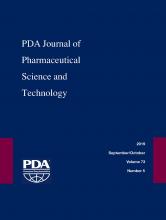Abstract
Bioburden data of municipal water, generated continuously with an online water burden analyzer sampling every two seconds (2 s), were subjected to a statistical analysis for the purpose of charting, evaluating the monitoring process behavior, and understanding when to take action and maintain the process under a state of control. The biocounts were recorded with a commercial analyzer that employs the intrinsic fluorescence of microorganisms as a result of laser excitation in order to generate a laser-induced fluorescence (LIF) signal. The real-time and continuous counting of optical signals leads to a stream of positively autocorrelated data. These high-frequency data, when plotted on Shewhart control charts, are difficult to interpret and exhibit a high rate of false alarm signals because of the autocorrelation. This paper analyzes an example set of data of water biocounts of one single day with the purpose of removing or minimizing the autocorrelation using model-based and model-free methods. This analysis can be equally applied to environmental monitoring of inert particles and microbes in the air in controlled rooms. The skip sampling and time series model methods were shown to remove the autocorrelation. The author favors the model-free method of “batch means control charts” whereby a “batch” or a number of successive data points is averaged and plotted on a standard Shewhart chart. The magnitude of this number depends on the knowledge of the given process and the purpose of the process control chart. Subsequently, the “batch means control charts” were made more meaningful and practical by setting limits that were determined under relaxed constraints. The ultimate outcome is converting high-frequency data to low-frequency data plotted onto standard control charts with practical limits and fewer false alarms, charts that reveal more clearly the underlying behavior and trends of the monitoring process.
LAY ABSTRACT: Bioburden data of municipal water, generated continuously with an online water analyzer sampling every 2 s, were subjected to a statistical analysis for the purpose of charting, evaluating the monitoring process behavior, and understanding when to take action and maintain the process under a state of control. This paper analyzes the data of biocounts of one single day with the purpose of removing or minimizing the autocorrelation using model-based and model-free methods. The skip sampling and time series model methods were shown to remove the autocorrelation. The author favors the model-free method of “batch means control charts” whereby a “batch” or a number of successive data points is averaged and plotted on a standard Shewhart chart. The magnitude of this number depends on the knowledge of the given process and the purpose of the process control chart. Subsequently, the “batch means control charts” were made more meaningful and practical by setting limits that were determined under relaxed constraints. The ultimate outcome is turning high-frequency data to low-frequency data plotted onto standard control charts with practical limits and fewer false alarms, charts that more easily reveal the trends of the monitoring process.
- Water bioburden
- Rapid microbiological method
- Real-time continuous monitoring
- laser-induced fluorescence
- Statistical process control (SPC)
- Autocorrelation
- Time series
- ARIMA model
- Rational sampling
- Batch means control charts
- Control charts of individual values
- Setting control limits
- © PDA, Inc. 2019
PDA members receive access to all articles published in the current year and previous volume year. Institutional subscribers received access to all content. Log in below to receive access to this article if you are either of these.
If you are neither or you are a PDA member trying to access an article outside of your membership license, then you must purchase access to this article (below). If you do not have a username or password for JPST, you will be required to create an account prior to purchasing.
Full issue PDFs are for PDA members only.
Note to pda.org users
The PDA and PDA bookstore websites (www.pda.org and www.pda.org/bookstore) are separate websites from the PDA JPST website. When you first join PDA, your initial UserID and Password are sent to HighWirePress to create your PDA JPST account. Subsequent UserrID and Password changes required at the PDA websites will not pass on to PDA JPST and vice versa. If you forget your PDA JPST UserID and/or Password, you can request help to retrieve UserID and reset Password below.






